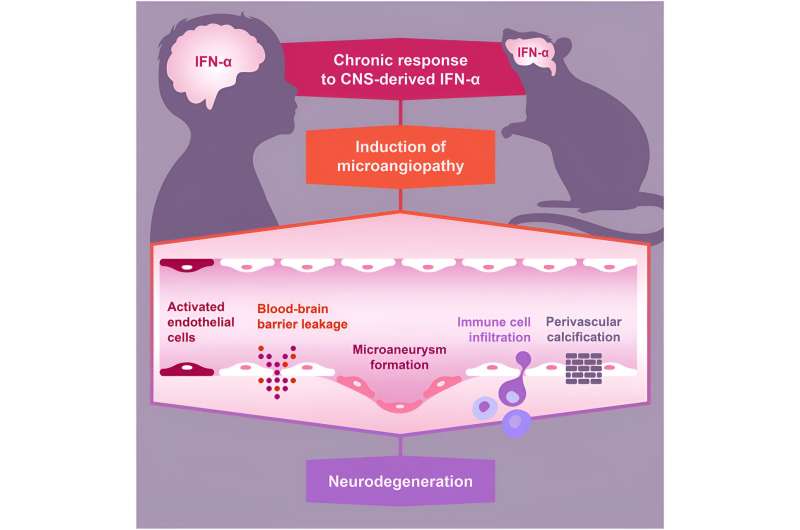This article has been reviewed according to Science X's editorial process and policies. Editors have highlighted the following attributes while ensuring the content's credibility:
fact-checked
peer-reviewed publication
trusted source
proofread
Promising pathway discovered to treat rare childhood brain disease

Aicardi-Goutieres syndrome is a rare disease that can trigger dementia in children. Associate Professor Markus Hofer and colleagues in the U.K. are focusing on treatments in the blood vessels in the brain to combat AGS.
A study co-led by Associate Professor Markus Hofer (The University of Sydney) and Professor David Hunt (UK Dementia Research Institute at Edinburgh) reveals fresh insight into the mechanisms underlying a rare disease that can cause childhood dementia.
The research, featured on the front cover of the journal Immunity, could lead to urgently needed new therapeutic targets for the condition.
The disease, Aicardi-Goutières syndrome (AGS), is an autoinflammatory condition, and one of about 100 rare neurodegenerative genetic disorders identified as a potential cause of childhood dementia. It affects the white matter in the brain and is caused by a mutation in one or more of a small group of genes.
The disease is characterized by abnormal production of a protein called interferon-alpha, which is usually produced by the body in response to viral infections.
However, where the interferon-alpha originates from and which parts of the brain it affects are not yet known. In this study, the researchers aimed to uncover how the brain responds to increased interferon-alpha in AGS, and how this leads to brain disease.
Associate Professor Hofer from the Charles Perkins Center and School of Life and Environmental Sciences said, "Research into AGS treatment is at a pivotal moment, and I am hopeful that this new discovery will pave the way for more effective therapies.
"This research is promising as its focus on blood vessels. Blood vessels, unlike brain tissue, are more readily accessible to drugs. This provides a pathway to treatment."
Professor Hunt said, "By identifying the brain as the primary source of the harmful interferon-alpha and revealing its damaging effects on the brain's small blood vessels, we have uncovered a potential target for urgently needed treatments."
This pathological process inspired the front cover image of the July issue of Immunity.
Leaves, like the human brain, have tiny, delicate microvasculature networks which maintain a healthy state. The devastating neurological changes mediated through cytokine-driven microvascular disease are depicted as a leaf changing from green to autumnal brown. The image was created by Ben Gartland, Grant Foster, and Holly Philip of the creative agency Ward6.

Methods and findings
Through comparing samples of cerebrospinal fluid from people with AGS to healthy controls, the researchers established that the brain itself is the source of harmful interferon-alpha in AGS. They then used a mouse model to replicate the over production of interferon-alpha, and revealed that the protein causes damage to the network of small blood vessels in the brain.
The team were able to show that removing interferon-alpha receptors from endothelial cells prevented the blood vessel damage in the brains of the mice, stopping the spread of the disease and prolonging the lifespan of the animals.
Impact
These results suggest that the small blood vessels in the brain play a key role in the damage seen in AGS, making them a potential target for treatment.
Professor Hunt said, "Our research provides important new insights into how Aicardi-Goutières syndrome leads to brain disease in children.
"These findings bring us closer to developing therapies that could significantly improve the quality of life and outcomes for children affected by this devastating condition."
Associate Professor Hofer has focused on neuroinflammatory diseases for the last two decades. His research aims to better understand pathological mechanisms and how they can be utilized to develop new treatments for patients.
The Hofer lab has established a unique transgenic mouse model that recapitulates many of the key features seen in patients with Aicardi-Goutières syndrome (AGS). AGS is part of a larger group of disorders collectively termed "cerebral interferonopathies," that all involve the chronic overproduction of a pro-inflammatory molecule, interferon-alpha.
Findings from this study will also have a broader impact on our understanding of how interferon-alpha mediates disease.
More information: Barney Viengkhou et al, The brain microvasculature is a primary mediator of interferon-α neurotoxicity in human cerebral interferonopathies, Immunity (2024). DOI: 10.1016/j.immuni.2024.05.017



















